19/08/2022 NFT Artists Are Not Selling ‘Digital Art Objects.’ They Are Selling a Story—One That Requires Constant Retelling
And that story better keep the degens excited.
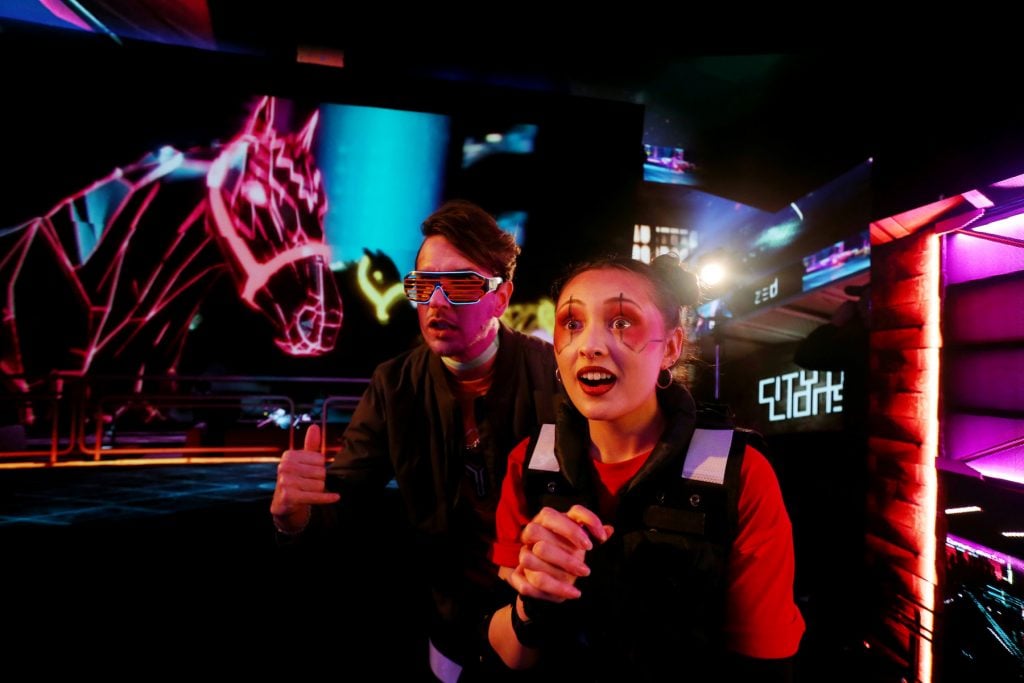 Performers Tyra Cartledge and Kendall Drury takes part in a virtual production connected to ZED RUN, the NFT-based digital horse racing game, on July 19, 2021 in Sydney, Australia. (Photo by Lisa Maree Williams/Getty Images)
Performers Tyra Cartledge and Kendall Drury takes part in a virtual production connected to ZED RUN, the NFT-based digital horse racing game, on July 19, 2021 in Sydney, Australia. (Photo by Lisa Maree Williams/Getty Images)“It’s very clear to us in recent days that NFTs may not be the future right now,” joked one of the hosts of theNifty Alpha Podcastrecently. “Like, it’s the future, but just not today.”
The Nifty Alpha Podcast is a jovial and pleasantly candid news source for NFT investors. Nifty Nick was doing a bit here, but he’s riffing on the larger truth: The NFT market is moribund. The overarching story of the moment is the bleeding of the major “blue-chip” NFT projects, with isolated spikes for this or that project that quickly fade away.
We are about a year and a half into the Great Mainstreaming of NFTs, and a few months into the first NFT winter.
Parts of the NFT universe are so obnoxious—the guys tweeting “HAVE FUN STAYING POOR” at skeptics; the influencers pumping up projects they are secretly invested in then cashing out; the endless supply of business hacks donning the mantle of digital art—that it is easy to have a lot of schadenfreude.
But I don’t really think NFTs are going away, actually. They are just mutating under the pressure.
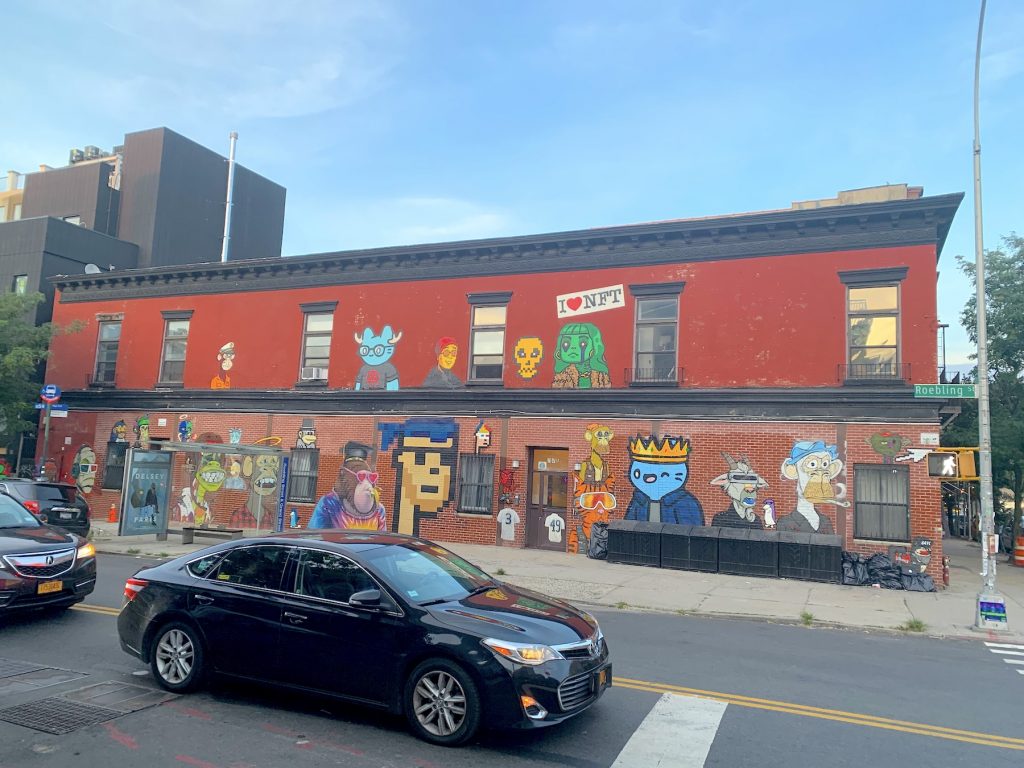
A hideous NFT-themed mural by Another Flex on the Wall in Williamsburg, Brooklyn. Photo by Ben Davis.
People promoting the alternative NFT art world tend to pronounce very confidently on the evils of the traditional art world, perceived to be hoarding economic opportunities that the magic of blockchain technology will open to all. But often it seems to me that this vision still buys the traditional art world’s hype.
The truth is that anyone who seriously studies the art market wouldknowthat traditional art is mainly a bad investment. Almost all new art is worth zero; even most art that has its moment will be worth nothing a few years later. In only truly exceptional cases does art appreciate radically over time, and those increases are nearly impossible to predict.
The main reason to collect art is because… you actually like art, or want to support artists. To be fair, I heard NFT experts now saying similar things at therecent NFT.NYC conference, in the face of crashing prices. (Six months earlier, atthe previous NFT.NYC, the more typical line was “who wants to retire in three years?”)
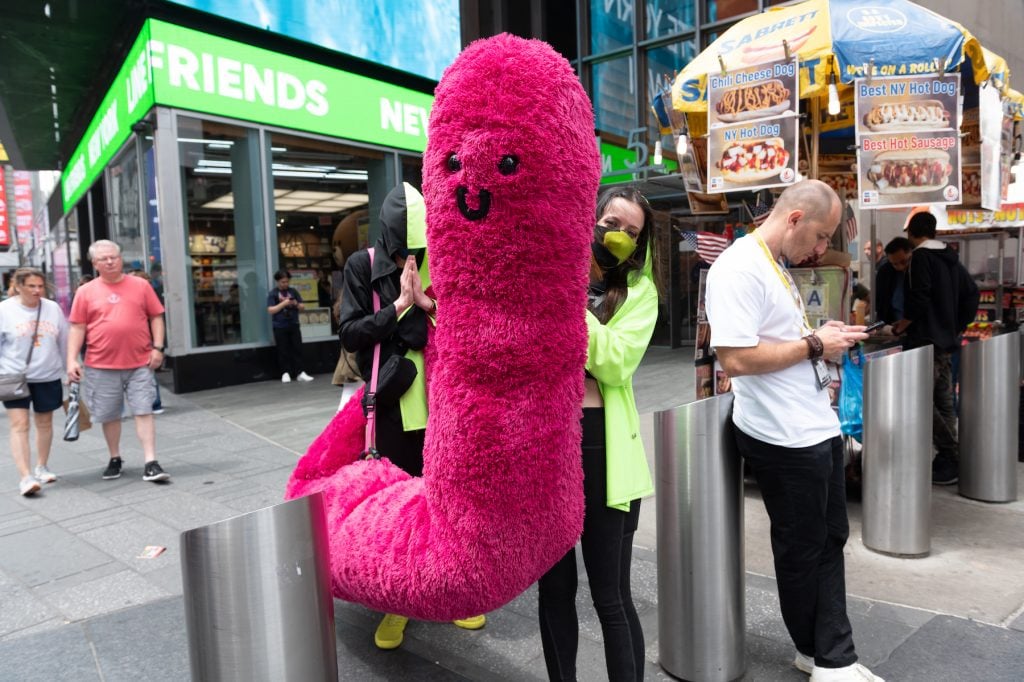
People walk with The Worm NFT character in Times Square during the 4th annual NFT.NYC conference on June 23, 2022 in New York City. .Photo by Noam Galai/Getty Images.
But it remains worth stressing: “democratizing” the financial opportunities of the art market mainly means democratizing the ability to lose money on hyper-speculative assets. As Bloombergreportedlast year, “A very small group of highly sophisticated investors rake in most of the profits from NFT collecting”—just like in the traditional art market.
And yet… just because most of the claims for the money-making potential of NFTs for the average person turn out to be smoke and mirrors doesn’t mean NFTs will go away. Criticscomparea lot of these crypto hustles to multi-level marketing schemes like Mary Kay and Herbalife, which also recruit people with huge promises of financial rewards which turn out to belargely illusory. But such companies have beencriticizedandsuedand investigated as pyramid schemes—and new people sign up to become evangelists for their products every year.
Such schemes tend to flourish among sections of the population who feel cut off from economic opportunities: Mary Kay amonghousewives; Herbalife amongimmigrants; and crypto and NFTs amongyoung menlooking at stagnating real-economy opportunities.
Another way to look at it: Culturally, the highly engaged audience of digital-art day traders really is something new, serving a mass audience of self-identified “degens” (from “degenerate gambler”) that has no parallel in the traditional art market. Most NFT projects are definitely bubbles—but the NFT art-and-collectibles trading ecosystem as a whole is something more like a new form of art-themed online gambling. It scratches the same itch as horse racing or sports betting, but for digital natives.

Zed Run, the NFT-based horse race game, sponsors Wakeful Stakes at Flemington Racecourse in Flemington, Australia. Pictured: winning IRL horse Willowy. (Reg Ryan/Racing Photos)
And gambling actually tends tothrive in economically uncertain times. In fact, the emerging field of “crypto addiction” istreatedas a subset of gambling addiction.
There is, nevertheless, a slightly less cynical reason to think that the trade in NFTs will stick around, on the artist side rather than the collector side. The innovation does reflect a way for digital creativity to be sustained, one that has been proven to be potentially viable in the last year, beneath the froth. Society is increasingly centered on digital creativity.
Again, however, I think some of what this means is obscured by the ordinary breathless NFT sales pitch. The advocates of web3 sound for all the world like they aremaking the pitchfromSilicon Valleyfor a “new internet,” without any satire. You hear a lot about how NFTs will finally free culture from the baleful grip of Web 2.0—that is, from the influence of the big platforms that have snarfed up most of the profit of the attention economy, your Alphabets and your Metas.

A billboard that reads, “I hate NFTs!” is seen behind people sitting on the red steps in Times Square during the 4th annual NFT.NYC conference on June 20, 2022 in New York City. (Photo by Noam Galai/Getty Images)
But as far as I can tell, success in the NFT space is very heavily based on the same viral dynamics and addiction to trending topics that have hollowed out the media in the Web 2.0 era. After a year and a half of seeing the NFT art world develop, what has become clear is that, even when a project catches fire, its medium-term value tends to follow the ordinary curve of viral fame and memes in general: There’s an initial intense pop of conversation as everyone tries to hop on a trend, which gets old quickly and rapidly becomes yesterday’s lunch.
Critics roll their eyes and talk about the absurdity of “buying jpgs.” But even this way of criticizing NFTs unintentionally embeds an unhelpful analogy. Collectors arenotbuying a digital image (or, rather, a token pointing to a digital image) that functions like a discreet painting, as a “digital object.” The most engaged NFT audience is looking fora story, a hype cycle whose fluctuations they can bet on.
To me, it seems like this is where a lot of more traditional artists coming into the NFT space go wrong, thinking they will just “do an NFT” that will then be sold to an audience that will passively hold it. It doesn’t work that way; the people who are looking to put money into these things are looking for a constant narrative to keep the price up. Continuous engagement is required.
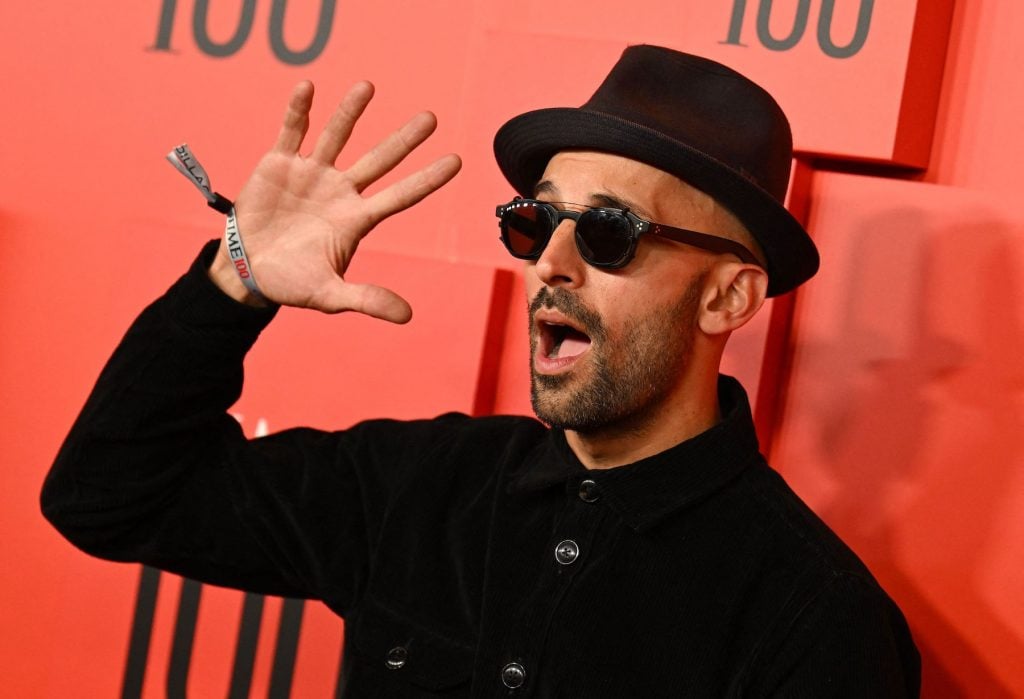
French photographer and street artist JR arrives for Time100 Gala at Lincoln Center in New York, June 8, 2022. Photo by Angela Weiss/AFP via Getty Images.
The artist JR got into NFTs last year, whichattracted great enthusiasm. As one can see on Discord, his collectors have been apoplectic that he hasn’t abandoned his other art to shill his NFTs more, to pump the project. An angry former fan recently even created a mocking animated version of his famous, sunglassed face, where JR is made to assure his NFT holders, in a shrill cartoon voice, “Hey guys, I haven’t forgotten about you! I think about you all the time I’m flying around the world spending all your money!” Brutal.
JR is one of the most famous, well-connected, and media-savvy street artists in the world. If he can’t just sit back and let the NFTs circulate on their own, neither can any other artist who wants something like an ongoing practice in the space.
The tendency for the NFT conversation to be dominated by large collections of slightly varied images flows from the need to have a story. A greater number of associated images means more transactions which in turn means more potential news events and data points to watch which in turn means more of a narrative to bet on.
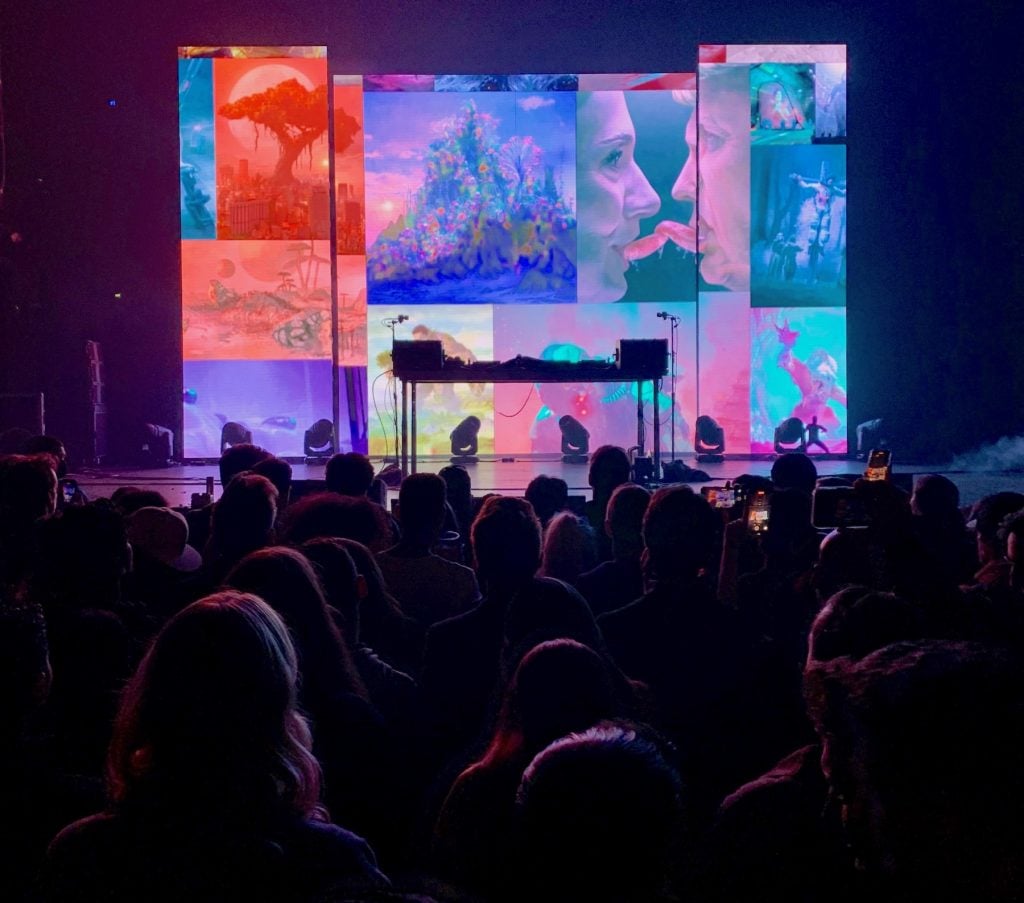
A film of Beeple’sEverydays – The First 5,000 Daysis shown at Dreamverse. Photo by Ben Davis.
When it comes to “one-of-one” art—the NFTway of saying“unique” artistic images rather than batches of digital collectables like the Apes or Punks—it seems significant that the most famous artist in the space, Beeple, had his fame grow out of his “Everydays” project of posting a new artwork… every day.
Constant attention, constant new hype, is what is demanded to keep the ball of interest in the air, to guarantee a continuous drip-drip of interest. And so, the effect of the NFT-ization of art feels more like an intensification of the demands on creative life in the age of social media and the tyranny of feeding the algorithm,nota more wholesome, up-with-people alternative to it.
Art has been traditionally associated with contemplation. Art in this space is going to be associated with being always-on, always hustling.
Sara Ludy, a successful digital artist based in New Mexico, recently spoke to my colleague Tim Schneider forthe Art Angle podcastabout the future of digital art. She talked enthusiastically of the huge breakthrough NFTs represent for digital artists, of being able to get money for previously unvalued work, and of being able to gain an audience for artists like herself who are based outside of geographic art capitals. These are real goods.
But this passage also stood out to me, and I think that every artist looking into NFTs should think about it:
I don’t think that NFT space is a healthy space because of what is required from artists to have to constantly be marketing and promoting yourself. You have to be plugged into Discord 24/7 and you are basically juggling several other aspects of what it means to be an artist, and it is exhausting. Personally, I am actually in a digital detox and reassessing what it means to have a healthy, sustainable digital practice. That spawned from burnout. I can barely open my computer screen right now and actually struggled with the last works of my show because I had burned out having to be online all the time.
I’m not betting on the total crash of NFTs right now. What Iambetting is that a lot of the same questions about the unsustainable dynamics of the web we know are going to return, but in an even more intense form.
 (0)
(0)
 (0)
(0)
https://news.artnet.com/market/nft-art-market-2022-selling-a-story-2160353
